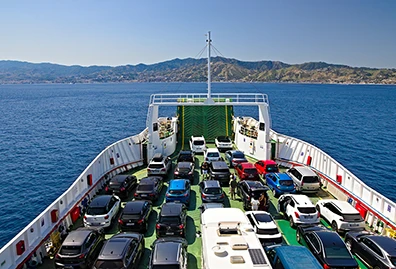Survitec encourages industry to prepare for new fire safety requirement for RORO and ROPAX ships
22/05/25

Survitec, a global leader in critical Survival Technology solutions, is calling on shipowners, ship managers, and shipyards to prepare for a significant change to international fire protection regulations. From 1st January 2026, fixed water monitors will be required on the weather decks of RORO and ROPAX ships under amendments to SOLAS Chapter II-2 and the FSS Code, approved by the IMO’s 107th MSC session.
The decision follows an increasing number of serious fire incidents involving vehicle cargo, including several high-profile incidents involving electric vehicles (EVs), that have exposed the limitations of existing fire protection measures.
As Rafał Kołodziejski, Head of Product Support and Development – Fire Systems at Survitec, explains, “The open and expansive nature of vehicle decks means that a fire can escalate very quickly, potentially spreading across the entire length of the ship. This incoming regulatory requirement puts a renewed focus on practical fire suppression systems that can be deployed quickly and effectively to extinguish or control a fire in these large, open deck spaces.”
Water is often the preferred choice of medium due to its efficient cooling properties; however, traditional sprinkler or deluge systems may not be sufficient. Fixed water monitors provide a rapid-response solution that can deliver additional, targeted, high-performance firefighting coverage. They are also a cost-effective, practical solution for smaller ships, where traditional deluge systems may be difficult to retrofit or maintain.
Remote-controlled options can be installed when access is limited and prevents manual operation. These allow crew to operate the water monitor from a safe location, providing additional firefighting capacity at reduced risk to crew.
The new rules specify that two fixed water monitors are required on ships with a breadth of less than 30 metres, and four monitors on wider ships. They must also deliver a minimum of 2.0 litres per minute per square metre, with a total flow of at least 1,250 litres per minute.
Michał Sadzyński, Product Manager at Survitec, stated, “Understanding how to interpret and apply the new rules is as important as the technical specification of the equipment itself. We can advise customers on the various monitor types that can be implemented to meet the new requirements, including manually operated, self-oscillating, hydraulic, and electrically controlled systems. Each type brings different advantages depending on the ship’s configuration, operating conditions, and available firefighting infrastructure.”
“Selecting the appropriate solution requires carefully assessing deck layout, coverage requirements, water supply capacity, and operational needs. Key considerations for equipment selection include operational reliability, ease of maintenance, installation flexibility, and environmental durability. Our water monitors also benefit from features such as corrosion-resistant construction and integrated cold-weather protection to ensure long-term effectiveness, essential for ships operating in varied or harsh conditions.”
As a maritime fire safety specialist, Survitec offers a wide range of water monitors as part of its fire safety portfolio and is well-placed to support its customers with technical consultancy and advice on implementation as part of a complete safety management solution.
“Prevention is always better than cure, especially where EV fires are concerned. Early monitoring and detection of fire remain key safety factors, but fixed water monitors can play a vital role in supporting a rapid, targeted response to contain and suppress fire,” adds Kołodziejski.
“Many in the industry are still unaware of the upcoming 2026 deadline. As the Team Trusted to Protect Lives, we welcome the opportunity to support our customers with this important development. While the regulation change represents a technical requirement, it is also a vital step forward in protecting lives and assets at sea.”
